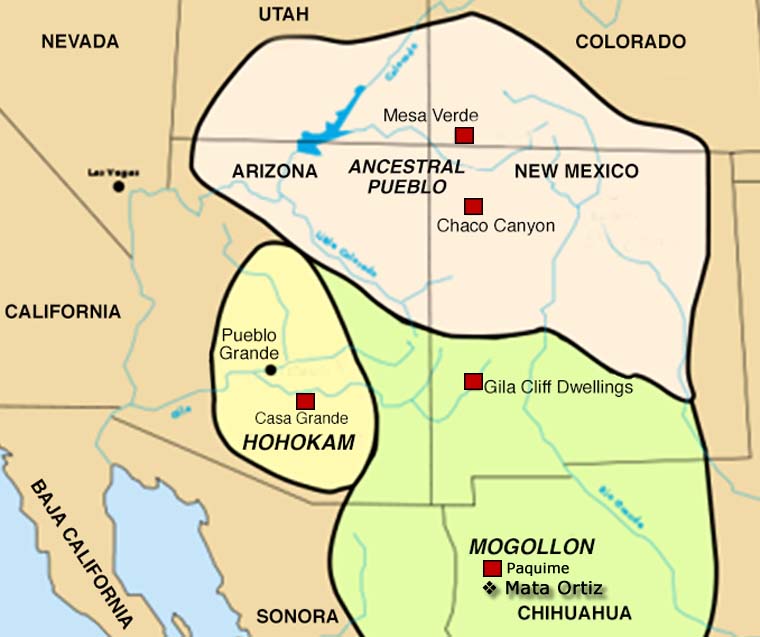
Angie Yazzie
Taos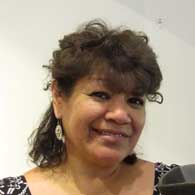
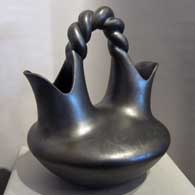
Angie Yazzie was born into Taos Pueblo in 1965. Her parents were Mary A. Archuleta of Taos Pueblo and Nick Yazzie of the Dineh (Navajo). In keeping with Pueblo tradition Angie was raised at Taos Pueblo.
Angie tells us she began making pottery when she was nine years old after being introduced to the basics by her mother and her maternal grandmother, Isabel Archuleta. Angie said she lived with her maternal grandparents for several years as a child and through them and their shop at the pueblo, she was exposed to the whole range of Pueblo arts and crafts. Clay Mother, though, is who Angie has heard calling her to work all these years.
After learning the barest basics, Angie struck out on her own and learned to make large golden and black micaceous ollas, like the ollas Taos was famous for making a hundred and more years ago. Micaceous clay has tiny flecks of mica spread throughout the clay. That mica makes it possible for a pueblo pot to hold liquids for cooking or storing. There are two seams of micaceous clay on the lands of Taos Pueblo: one golden and one black.
Angie has told us her favorite shape to make is a large, fluted water jar, slipped with micaceous clay. It is exactly that type of jar that has earned her Best of Division and First Place ribbons at the Heard Museum Guild Indian Art Fair, Best of Division and First, Second and Third Place ribbons at the SWAIA Santa Fe Indian Market and First Place ribbons at the Eight Northern Pueblos Arts and Crafts Show. Angie recently had a piece placed on display at the Winona State College Museum in Winona, Minnesota.
Angie says she still gets her inspiration from her fond memories of her maternal grandmother. At the same time, she loves to look at other artists creations and talk to them about how they made it.
Some of the Awards Angie has Won
- 2020 Heard Museum Guild Indian Fair & Market: Judge's Award - Upton Ethelbah Greyshoes, Jr. Awarded for artwork: "Give Me Water"
- 2018 Santa Fe Indian Market: Classification II - Pottery, Division A - Traditional Unpainted Pottery, Category 502 - Micaceous Ware in the style of Taos, Nambe, Picuris, any form: First Place
- 2018 Heard Museum Guild Indian Fair & Market, Classification II - Pottery, Division B - Unpainted, including ribbed, native clay, hand built, fired out-of-doors: First Place. Awarded for artwork: Black Fluted Vase
- 2018 Heard Museum Guild Indian Fair & Market, Classification II - Pottery, Division G - Pottery miniatures not to exceed three (3) inches at its greatest dimension: Honorable Mention. Awarded for artwork: Rectangle Prayer Plate
- 2017 Santa Fe Indian Market: Classification II - Pottery: Best of Classification
- 2017 Santa Fe Indian Market: Classification II - Pottery, Division A - Traditional Unpainted Pottery: Best of Division
- 2017 Santa Fe Indian Market: Classification II - Pottery, Division A - Traditional Unpainted Pottery, Category 502 - Micaceous Ware in the style of Taos, Nambe, Picuris, any form: First Place
100 West San Francisco Street, Santa Fe, New Mexico 87501
(505) 986-1234 - www.andreafisherpottery.com - All Rights Reserved

Mata Ortiz and Casas Grandes
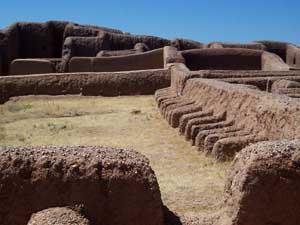
The macaw pens at Paquimé
Casas Grandes is both a municipality and an archaeological district in northern Chihuahua State, Mexico. The archaeological district includes the pre-historic ruins of Paquimé, a city that began to build around 1130 AD and was abandoned about 1450 AD. Archaeologists are uncertain as to whether Paquimé was settled by migrants from the Mogollon/Mimbres settlements to the north or by Anasazi elite from the Four Corners region in the United States or by others. Over the years Paquimé was built into a massive complex with structures up to six and seven stories high with multiple Great Houses in the surrounding countryside. Today, the site is a UNESCO World Heritage Site.
Mata Ortiz is a small settlement inside the bounds of the Casas Grandes municipality very near the site of Paquimé. The fortunes of the town have gone up and down over the years with a real economic slump happening after the local railroad repair yard was relocated to Nuevo Casas Grandes in the early 1960's. The town was in steady decline until Juan Quezada, a poor farmer who gathered firewood in the area of the archaeological site, was inspired by fragments of ancient Paquimé pottery and even older fragments of Mimbres forms with bold black-on-white designs littering the ground to learn more.
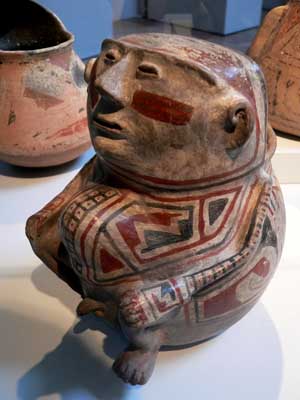
Ramos Polychrome effigy pot from Paquimé
Quezada was successful in his quest to learn to recreate the ancient process using slightly more modern techniques (although no one in the present tradition uses a potter's wheel). He learned to use sand and other coarse materials for temper. He discovered that dried cow dung made an excellent and inexpensive firing fuel. Instead of using gourds for smoothing he substituted broken hacksaw blades. Instead of using yucca fiber brushes for painting he learned to make brushes with human hair. He persevered in his efforts and by 1971 had produced a kind of polychrome pottery. Since then, most pottery-making in the area has used innovations in the design and decoration of the pots but the materials and the basic crafting of the process have remained the same.
By the mid-1970s, Quezada had attracted a significant number of traders and his work was becoming a commercial success. That is when he began teaching his techniques to his immediate family. They in turn taught other family members, friends and the younger generations. Both women and men were included from the beginning.
Originally called Casas Grandes pottery in the early years of its production, the potters of this tiny village have made such an impact on the pottery communities, including many awards and special recognition from the Presidents of Mexico, that Mata Ortiz pottery is now becoming known around the world.
Today, pottery production has changed the village in many ways as there is now electricity, plumbing, vehicles and more for the residents. Virtually everyone in the small town (2010 population: 1,182) makes their living by working in some part of the pottery-making process, from potters to clay-gatherers to firewood collectors to traders.
Mata Ortiz pottery incorporates elements of contemporary and prehistoric design and decoration, and each potter or pottery family produces their own distinctive, individualized ware. Young potters from surrounding areas have been attracted to the Mata Ortiz revival and new potting families have developed while the art movement continues to expand. Without the restraints of traditional religious practices or gender constraints, a vibrant flow of new ideas has enabled the pottery of Mata Ortiz to avoid the derivative repetition common to virtually all folk art movements. This blend of economic need, gender equality, cultural expression and artistic freedom has produced a unique artistic movement in today's community.
Lower photo is courtesy of David Monniaux, Creative Commons Attribution-Share Alike 3.0 Unported License
100 West San Francisco Street, Santa Fe, New Mexico 87501
(505) 986-1234 - www.andreafisherpottery.com - All Rights Reserved
